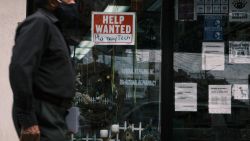Editor’s Note: A version of this story appeared in CNN’s Work Transformed newsletter. To get it in your inbox, sign up for free here
Kathryn Vasel has taken a well-deserved day off. For today’s newsletter, CNN Business’ Jeanne Sahadi is our guest writer.
A friend of mine suggested recently, “Let’s just designate 2020 as the worst year ever, shall we?”
It’s hard to argue with that sentiment when we’re simultaneously facing a pandemic, searing economic disruption and yet another explosion of systemic violence against Black people.
But maybe – at least as far as work is concerned – 2020 is also sowing the seeds for some long overdue transformations.
Take racism. Corporate America knows very well – and has known for years – that it has a problem withdiversity and racism in its ranks.Just look at the abysmally small number of Black executives who run Fortune 500 companies.
And the cultural reckoning with racism spurred by the brutal police killing of George Floyd is showing many White CEOs that simply acknowledging racism, making corporate donations to anti-racist groups and bumping up vague diversity efforts won’t cut it anymore.
What’s more, they’ve seen the demographic projections showing that non-Hispanic Whites will fall below 50% of the US population by 2045. And they’re getting public messages loud and clear that now is the time to meaningfully increase diversity in talent pipelines, C-suites and boardrooms.
Otherwise, “another generation kind of goes by the wayside of people who can be helpful, who can increase shareholder value, who can represent the stakeholders and create a just Corporate America,” former Xerox CEO Ursula Burns told CNN’s Poppy Harlow.
Indeed, there is growing awareness that a diverse leadership team and employee pool is good for the bottom line because the voices of a company’s consumer base will be better represented at the table.
Entrepreneur Tristan Walker, founder of a company that makes personal care products for people of color, suggested that CEOs who believe they value fairness and inclusion should ask themselves: “Are you hiring folks who represent the audience that you’re serving? Are you putting folks on your boards who represent the audience that you’re serving?”
Calling out toxic workplace cultures
When it comes to tolerating toxic workplace cultures,employees increasingly aren’t having it.
They have become much more vocal on social media and through their unions in publicly alleging unfair treatment by the higher-ups.
That’s what happened at Refinery29, a women-centric site that bills itself as an inclusive employer and publication dedicated to amplifying underrepresented female voices. It turns out its internal culture might not be as supportive and inclusive asthe publication’s stated mission, according to employee complaints and a lengthy investigation by CNN Business’ Kerry Flynn.
Soon afteremployees’ allegations became public, Refinery29 parent Vice Media Group announced it was launching an investigation, led by an outside law firm.
Among the claims: Editor-in-chief Christene Barberich made some editorial decisions that diminished Blackwomen and other women of color who worked at Refinery29. Barberich stepped down earlier this month, admitting that she failed to fulfill the company’s mission.
You can read more about Vice Media Group’s investigation and Flynn’s in-depth reporting here and here.
The new rules of staying safe at work
If your employer has asked you to return to the office or work site, the actions you take while there can go a long way toward protecting you from contracting Covid-19.
But they will require you to sweat the small stuff – in addition to wearing a mask and keeping your distance from others.
“You want to think about every surface you touch. You’ve gotta be thinking about this constantly,” said CNN’s Dr. Sanjay Gupta in a video he created to demonstrate some best practices and what to expect when you do go back to your workplace.
Hand sanitizer should be everywhere, but be sure to carry some of your own as well. Use it liberally.
Clean any surface you plan to use or touch with disinfecting wipes.
Take stairs whenever you can, Gupta recommends, because elevators are small, enclosed spaces without great air circulation.
If you must take an elevator, look for one that’s empty or at least not crowded. If there are other people in it, everyone should be facing the same way toward the door to minimize the chance of exposure to viral droplets or viral particles in the air. Use a pen or other object to select the button for your floor.
And try not to sit directly opposite someone for the same reason – to reduce viral transfer.
Watch Gupta’s video here for even more tips.
Coffee break
It’s officially summer. And you’re officially exhausted.
If you plan to take some time off and are deciding whether to get out of Dodge, you’ll have to weigh the risks of flying versus driving in this global pandemic.
The good news is that CNN’s Marnie Hunter has laid out those risks here for you to compare and contrast.
But, as with every mind-bending question raised by the coronavirus and made worse by the confusing mess of governmental responses to it, there is no perfect answer. Much depends on where you’re going, your risk tolerance and how you and your family choose to behave along the way.
If those mental calculations alone tucker you out, remember, it is perfectly okay to just stay home, tune the world out and rack up frequent napping points this year.



























